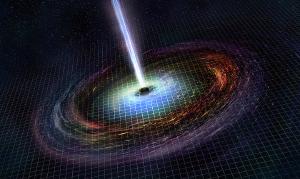Blog
Baby Announcement
7 June 2018
 NASA/CXC/M.Weiss
NASA/CXC/M.WeissNow that we have gravitational wave astronomy, we’re able to study strong cataclysmic events such as the merging of two astronomical bodies. The early observations of gravitational waves saw merging black holes, but in August of 2017 we observed gravitational waves from the merger of two neutron stars. This allowed us to study how neutron stars can produce black holes.
It’s long been thought that two large neutron stars could merge to create a black hole. But we couldn’t be entirely sure. In theory, with enough mass a neutron star will collapse under its own weight. But the upper limit for the mass of a neutron star depends upon its composition, something we still don’t entirely understand. The best theory we have puts the upper limit at about 2.2 solar masses, but it could be larger. So when two neutron stars merge they might produce a black hole, but they might also produce a larger neutron star.
The combined mass of the neutron stars that merged in 2017 was about 2.7 solar masses. That’s theoretically enough mass to produce a black hole, but some of the mass escapes during the collision. This particular merger created a gamma ray burst, releasing a tremendous amount of energy. So the final mass after the collision is in the upper range of a possible neutron star, but still above the limit of our best model.
To determine whether the merger produced a neutron star or black hole, astronomers observed the object1 with the Chandra X-ray Observatory. When a neutron star is formed, the star’s rotation generates a tremendous magnetic field. This excites charged particles near the neutron star, creating a strong x-ray source. By contrast, the formation of a black hole can heat surrounding material to produce x-rays, but the x-rays fade as the material cools. So a strong x-ray source would indicate a neutron star, while fainter x-rays would indicate a black hole. Chandra observed an initial rise in x-rays after the merger, but these are consistent with material heated by a shock wave from a new black hole. So far, the x-ray source hasn’t strengthened to the level expected from a neutron star.
So it looks like the neutron stars produced a black hole. And it all started with a birth announcement delivered by gravitational waves.
Pooley, David, Pawan Kumar, and J. Craig Wheeler. “GW170817 Most Likely Made a Black Hole.” arXiv preprint arXiv:1712.03240 (2017). ↩︎